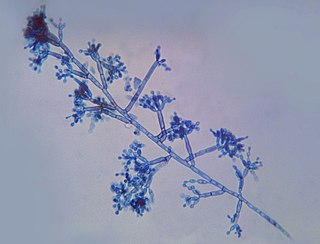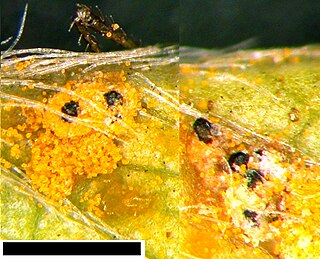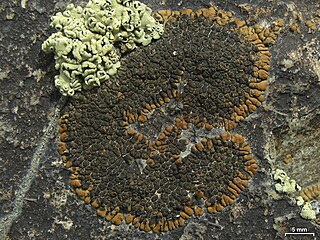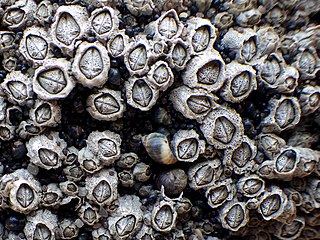
Eurotiomycetes is a large class of ascomycetes with cleistothecial ascocarps within the subphylum Pezizomycotina, currently containing around 3810 species according to the Catalogue of Life. It is the third largest lichenized class, with more than 1200 lichen species that are mostly bitunicate in the formation of asci. It contains most of the fungi previously known morphologically as "Plectomycetes".

The Hypocreales are an order of fungi within the class Sordariomycetes. In 2008, it was estimated that it contained some 237 genera, and 2647 species in seven families. Since then, a considerable number of further taxa have been identified, including an additional family, the Stachybotryaceae. Wijayawardene et al. in 2020 added more families and genera to the order. According to the Catalog of Life, As of April 2021 the Hypocreales contains 6 families, 137 genera, and 1411 species. Hyde et al. (2020a) listed 14 families under Hypocreales, while, Wijayawardene et al. (2022) accepted 15 families in the order, where Cylindriaceae was additionally added. Earlier, Hyde et al. (2020a) had placed Cylindriaceae in class Xylariomycetidae. Samarakoon et al. (2022) agreed. Hence, Cylindriaceae should have been excluded from Hypocreales and placed in Xylariomycetidae. Xiao et al. (2022) recently introduced a new family Polycephalomycetaceae to Hypocreales.

The Chaetothyriales are an order of ascomycetous fungi in the class Eurotiomycetes and within the subclass Chaetothyriomycetidae. The order was circumscribed in 1987 by mycologist Margaret Elizabeth Barr-Bigelow.

The Phaeosphaeriaceae are a family of fungi in the order Pleosporales. Species in the family have a cosmopolitan distribution, and are generally nectrotrophic or saprobic on a wide range of plants.
The Pleomassariaceae are a family of fungi in the order Pleosporales. Taxa have a widespread distribution in both temperate and tropical regions, and are saprobic or necrotrophic on wood, bark, and other herbaceous material. The genus was circumscribed by mycologist Margaret Elizabeth Barr-Bigelow in 1979.

The Ostropales are an order of fungi in the class Lecanoromycetes. The order was circumscribed by Swedish botanist John Axel Nannfeldt in 1932. The order contains 4 families and 46 genera, including 6 genera of uncertain familial placement.

Sphaerellothecium is a genus of fungi in the family Phyllachoraceae. All of the species in the genus are lichenicolous, meaning they grow parasitically on lichens.
Capronia is a genus of fungi in the family Herpotrichiellaceae. It has about 80 species.
The Hyponectriaceae are a family of fungi, that was formerly in the order Xylariales. It was placed in the Amphisphaeriales order in 2020.
Endococcus is a genus of lichenicolous (lichen-dwelling) in the family Lichenotheliaceae. It has 44 species. The genus was circumscribed by the Finnish botanist William Nylander in 1855. Although at least one source places the genus in the Verrucariaceae, a 2016 study of the type species, Endococcus rugulosus, determined that it should instead be placed in the family Lichenotheliaceae of the order Dothideales; this classification echoes a placement proposed in 1979 by David Hawksworth.
Didymocyrtis is a genus of lichenicolous fungi in the family Phaeosphaeriaceae. The genus was circumscribed by Finnish lichenologist Edvard August Vainio in 1921, with Didymocyrtis consimilis assigned as the type species.

The Bionectriaceae are a family of fungi in the order Hypocreales. A 2008 estimate places 35 genera and 281 species in the family. Species in the family tend to grow on plant material, including woody debris, while some species associate with algae, bryophytes, or other fungi.
Pronectria is a genus of fungi in the family Bionectriaceae. It consists of 44 species, all of which are lichenicolous. The genus was circumscribed by American plant ecologist Frederic Clements in 1931.

Xanthopyreniaceae is a family of lichen-forming fungi in the order Collemopsidiales. The family was circumscribed by lichenologist Alexander Zahlbruckner in 1926.
Rhymbocarpus is a genus of lichenicolous (lichen-dwelling) fungi in the family Cordieritidaceae. It has 10 species. The genus was circumscribed by German mycologist Friedrich Wilhelm Zopf in 1896, with Rhymbocarpus punctiformis assigned as the type species.
Spirographa is a genus of parasitic fungi. It is the sole genus in the monotypic family Spirographaceae, belong to the order Ostropales. The genus was circumscribed by Alexander Zahlbruckner in 1903, with Spirographa spiralis later assigned as the type species in 1923. The family Spirographaceae was circumscribed by Adam Flakus, Javier Etayo and Jolanta Miadlikowska in 2019 on the basis of molecular phylogenetic analysis. They determined that genus Spirographa is an independent lineage in the Ostropales, sister to the clade containing the families Fissurinaceae, Gomphillaceae, and Graphidaceae.
Nanostictis is a genus of lichen-forming fungi in the family Stictidaceae. The genus was circumscribed in 1954 by Danish lichenologist Mogens Skytte Christiansen, with Nanostictis peltigerae assigned as the type species.
The Niessliaceae are a family of fungi in the phylum Ascomycota, class Sordariomycetes. The family was updated in 2020.
Lichenotubeufia is a genus of lichenicolous fungi in the family Tubeufiaceae. The genus was circumscribed by Spanish mycologist and lichenologist Javier Etayo in 2017, with Lichenotubeufia eriodermatis assigned as the type species.
Crittendenia is a genus of lichenicolous (lichen-dwelling) fungi in the monogeneric family Crittendeniaceae. The genus was circumscribed in 2021 to contain two species, C. lichenicola, and the type, C. coppinsii. An additional 16 species were added to the genus the following year. The genus name honours British lichenologist Peter Crittenden.








